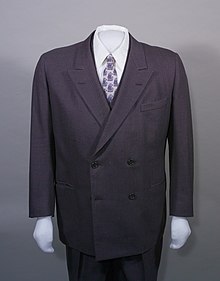| This article may need to be rewritten to comply with Misplaced Pages's quality standards. You can help. The talk page may contain suggestions. (November 2017) |
| This article needs additional citations for verification. Please help improve this article by adding citations to reliable sources. Unsourced material may be challenged and removed. Find sources: "Sharkskin" – news · newspapers · books · scholar · JSTOR (July 2024) (Learn how and when to remove this message) |
Sharkskin, or grisaille (from french gris, meaning grey) describes a specific woven or warp-knitted fabric with a distinctive sheen. Sharkskin is a twill weave fabric created using acetate, rayon, worsted wool, lycra, and other plastic fibers.
The arrangement of darker and brighter threads in a twill weave creates a subtle pattern of lines that run across the fabric diagonally and a two tone, lustrous appearance. Primarily a suiting material, the fabric is sometimes seen in light jackets and non-fashion items such as curtains, tablecloths, and as a liner in diving suits and wetsuits.
Composition

| This section may need to be rewritten to comply with Misplaced Pages's quality standards. You can help. The talk page may contain suggestions. (May 2023) |
Sharkskin has historically been made with different types of natural fibers, including mohair, wool and silk.
More expensive variations exist and are often demarcated by fabric content labels bearing "Golden Fleece" or "Royal" titles. These indicate an older style of sharkskin fabric that was extremely rare and were costly to produce. These fabrics produced in small quantities, were manufactured in South America by transplanted German and Italian weavers during the 1950s and 1960s. The South American produced sharkskin included local materials such as vicuna, guanaco, or alpaca in such blends.
Natural sharkskin fabric was made primarily using silk fibers woven to create a signature two-tone patter.
Artificial variations
Artificial sharkskin variants used for suiting first appeared in the 1950s. These variants made more significant use of wool and synthetic fibers in their construction. The addition of synthetics can create a heightened metallic-like sheen, and/or added flexibility. Artificial sharkskin, in part for its comparably low price point, gained traction as a clothing material in the early 1960s and the disco era of the late 70s. Its popularity waned, but enjoyed brief fashion resurgences in the mid-1980s, mid-1990s and late 2000s.
Middle East
British diplomat Sir Terence Clark in the 1950s served in Bahrain. He reminisced that the requisite winter evening wear for a diplomat was a white sharkskin dinner jacket. Lucette Lagnado in her prize-winning memoir about her childhood, The Man in the White Sharkskin Suit: My Family's Exodus from Old Cairo to the New World uses the imagery of the white sharkskin suit to evoke the glamorous evening life in Egypt in the 1950s. Early in Justine, Lawrence Durrell mentions the heroine sitting in front of a multi-panel mirror trying out a sharkskin dress; the book is set in the high society of diplomats and businessmen in Alexandria in the 1930s, a city where Durrell spent much time during World War II, a few years later.
See also
References
- The Textile Institute and Industry - Volume 5. The University of Michigan: Textile Institute. 1967. p. 174.
- Frank Pollatsek, William Seitz, Louis Goldblatt (1952). Fabrics Today and Drycleaning - Volume 1. Origin University of Minnesota: New York Neighborhood Cleaners Association. p. 36.
- Tregonning, Melwyn. Fabric Dictionary. Mel Tregonning.
- Harris, Milton (1962). Natural and Synthetic Fibers Yearbook. p. 156.
- Churchill College Cambridge. "British Diplomatic Oral History Programme (BDOHP)". Archived interview: Former member of the British Diplomatic service Charles Cullimore interviews fellow diplomat Sir Terence Clark on Friday 8, November 2002. Retrieved June 8, 2011.
- "BBC Home - Breaking News, World News, US News, Sports, Business, Innovation, Climate, Culture, Travel, Video & Audio". www.bbc.com. Retrieved 2024-07-02.